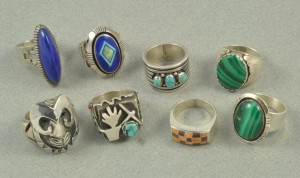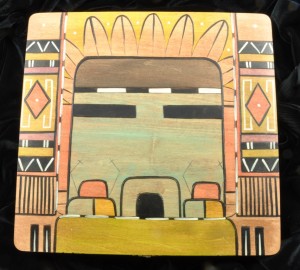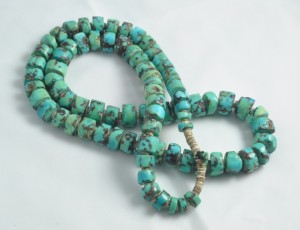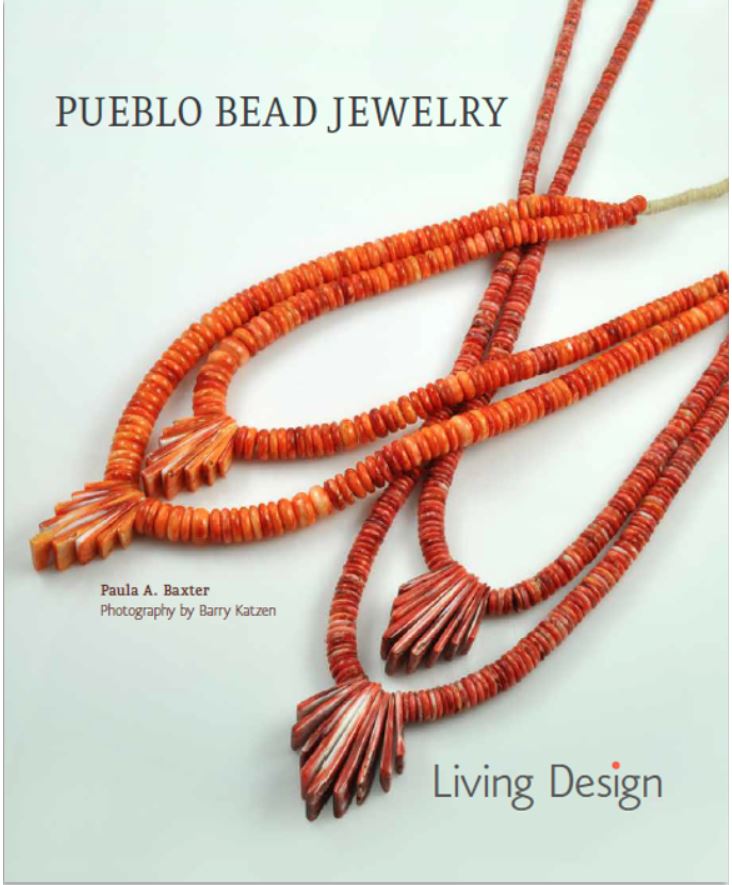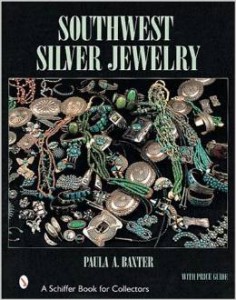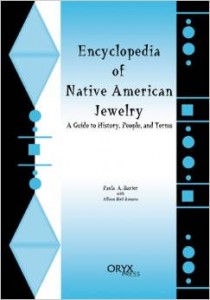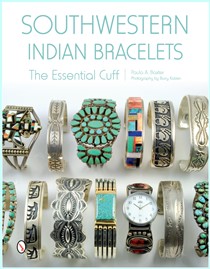Navajo weavings are a wonderful category of Indian-made art. These textiles, old and new, bear testimony to the artist’s eye for small details that pack a punch. Like clouds and scenes from reservation life, a weaving can come alive when animals are introduced. The tree of life weavings come to mind at once, but then there are those compositions that portray the sturdy chipmunk, carefree Kaibab squirrel, or anxious cottontail. One of my favorite categories is the pictorial weaving, where the introduction of animals makes the entire composition that much livelier. We were fortunate in the late 1980s to obtain a small weaving by the artist Fanny Pete that consists entirely of rabbits! It’s the pride of our home and I’d never let our amazingly spoiled bunnies anywhere near it. For those of you unacquainted with domestic rabbits—they chew textiles like puppies…
Recently the New York Times had an article on “36 Hours in Albuquerque.” It’s got interesting tips on the new and trendy, but it left out the best places for Indian jewelry and pottery. We can fill that gap right now:
Wright’s Indian Art: This is the oldest of the three business mentioned here. Wright’s was founded back in 1907, and was originally on Route 66 (where “everything” used to be in Albuquerque). They offer a wide selection of excellent Native American jewelry, pottery, paintings, fetishes and other examples of the best available.
Cowboys and Indians Antiques: If you’re looking for vintage Native American (and Western) art, including jewelry, Navajo weavings, Pueblo pottery, andHopi kachinas, this is the place for you. They’re on historic Route 66.
Andrews Pueblo Pottery: This Old Town business has a wonderful selection of Native American pottery, plus other Native art such as painting and sculpture. They also have some fine Indian jewelry. Andrew Pottery has ben a source of fine Native American art since 1974.
Disclaimer: While we purchase merchandise from these companies, we have not received any gifts or remuneration from them in return for mentioning them in this website.
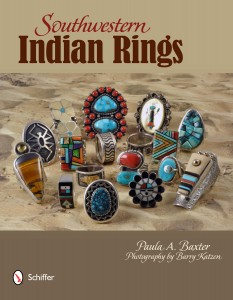 Southwestern Indian Rings
Southwestern Indian Rings
by Paula A. Baxter
Photography by Barry Katzen
Visit Amazon for its discounted price
With a fascinating variety of American Indian rings from the southwestern United States shown in more than 360 color photos, Southwestern Indian Rings
provides a design history of these rings, beginning with pre-contact artifacts and continuing through to contemporary artistic innovations.
The text surveys key developments in Native American ring design; materials and methods of construction; definitions for historical and vintage rings; master innovators; and the transition from craft to wearable art since 1980.
Shortly after the Civil War, Native American artisans began making silver rings set with turquoise, coral, jet, mother-of-pearl, and colored shell, adding lapis, malachite, onyx, and petrified wood over the decades. More recently, artisans began utilizing gold and such non-traditional settings as opals and diamonds, among others.
Works by Navajo and Pueblo artists are featured, although Apache, Northern Cheyenne, and Sonoran Desert Native jewelers are also included. A guide to valuation issues and resources is offered for collectors.
978-0-7643-3875-5
hardcover $34.99 (but Amazon is giving a discount)
8 1/2 x 11
160 pages
361 color photos
For the third time, we tried to visit Toadlena Trading Post and failed. We attempted two times back in the mid-to-late 1990s when we were doing our roving trading post visits. We found Two Grey Hills on the dirt road, but no luck when it came time to sight Toadlena. On our recent visit last month, we were traveling on Route 491 (former Rte. 666) from Gallup to Shiprock and back. We knew the turnoff was around Newcomb, we had our maps out, and there were some signs not far out of both Gallup and Shiprock. Yet we failed again.
The culprit, we realized, was the fact that New Mexico DOT is working on Route 491 in that area, doing bypass construction and road widening. Subsequently, the turnoff from 491 wasn’t indicated. We’ve been pretty excited about the work that Mark Winter and staff have been doing to make this 1890s trading post come alive again with weaving talent and the chance for the visitor to have an artful museum experience. Nevertheless, a well-placed sign at the turnoff would help everyone. Maybe the construction workers moved it. We’ll try to find this elusive trading post yet again on a later trip. In the meantime, if you plan to visit — get your GPS going!
One of the most welcome sights from our recent visit to Gallup was a new storefront proclaiming Bill Malone Trading Co. Malone is one of the most experienced of the old time Indian traders left in the business; he also married into the Navajo, and his son-in-law is Perry Shorty, one of the most talented Navajo jewelers in business and a star of the SWAIA Indian Market. Perry always sells out of his booth holdings in record time.
Malone has not had an easy decade. Bureaucratic ineptitude led to his being removed from a longtime position as trader at Hubbell Trading Post, and the story, a fascinating one for those of us suspicious of governmental management practices, can be found in The Case of the Indian Trader. Malone had gone on to run Shush Yaz in Gallup, but we found him now at his own shop at 235 W. Coal Avenue, on the block right behind Richardson’s Trading Co. He sells mostly Navajo arts, and his rugs, pots, baskets and jewelry are of great quality. My friend and I found vintage watchbands with fine coral stones there, a commodity hard to get nowadays. A practical-minded man, he also offers watch battery replacements and jewelry repairs. The presence of this reputable trader in town is a bonus indeed, and his shop’s wares are the product of a genuine understanding and affinity for the best in Native-made arts.
We recently received a report from a usually reliable source about a practice that happens at the Inter-Tribal Indian Ceremonial, held in Gallup at Red Rock State Park. This event most often takes place the week and weekend before the SWAIA Indian Market in Santa Fe. The Inter-Tribal has had a rough patch related to funding, but is still considered one of the important shows in the summertime calendar of Indian arts. Native artists submit their work for judging and display, and the judges tend to be experienced Indian traders and regional experts.
It turns out that artists pay a holding fee to keep the judged art on display through the length of the Ceremonial; this fee also causes some of them to place an extraordinarily high price on a prize-winning piece in the hopes of not selling it at Ceremonial, since it can get a higher price as a result at the Indian Market or elsewhere. An award from the Ceremonial judges is a known boost in value for such a work.
Some of the crafts previously made as lower cost items for sale to outsiders have developed a new life. We’ve learned that the fairly inexpensive, Indian symbol-driven sandpaintings done for tourist consumption have taken a new form. Navajo artists with art training and talent are producing pieces with non-symbolic subjects, including figural studies, landscapes, and scenes from daily life or popular culture. Check on YouTube for a video by the Ettcity Boys demonstrating how to make such a picture. The artists are—you guessed it—young individuals who are striving for a new look to an old-time tourist collectible. Young Native women (and a few men) with a talent for sewing are also making “Indian style” garments and accessories for sale, spurred on by the growth of this category at shows and in real life. Keep your eye out for tote bags and purses with a Southwestern flair.
I’ve written an article on this topic for the August issue of The Journal of Antiques and Collectibles. Collectibles have grown as a consumer fancy for collectors over the last thirty years. American Indians have been a source of fascination to non-Native peoples for a long time. Indian collectibles, however, reflect some of the cultural stereotypes and inaccuracies assumed by non-Indians. Most 20th-century school children grew up thinking that tomahawks, canoes, drums, feathered headdresses and beaded items were representative of Indian culture in general. Hollywood didn’t help matters by making all on-screen Natives into Plains Indians.
Japanese manufacturers responsible for restoring an economy ruined by World War II were quick to find American Indians a suitable subject for sentimental ceramics. Tourist collectibles made in the 1940s, 1950s, and 1960s are charming because of their exaggeration. Manufacturers did not worry about political correctness; in fact, the people they made these items for wanted something humorous. Indian maidens, chiefs in headdresses, mock-sacred spirit figures — all were fair game for the designer. Tourist items were intended to be portable souvenirs or gifts for those who had to stay home.
The small-sized items produced for sale at Fred Harvey Company hotels, restaurants, and tourist outlets — like Desert View on the South Rim of the Grand Canyon — are amazingly popular and have kept their collectible nature. Prices were quite low, especially for manufactured goods, until this past decade. Collectors examining Fred Harvey objects such as jewelry are experiencing sticker shock these days. As more and more individuals have taken notice of a unique form of Americana, those small bracelets with stamps of horses and whirling logs or strands of turquoise shaped by Santo Domingo Indians, have seen a 20-35% increase in sale price.
